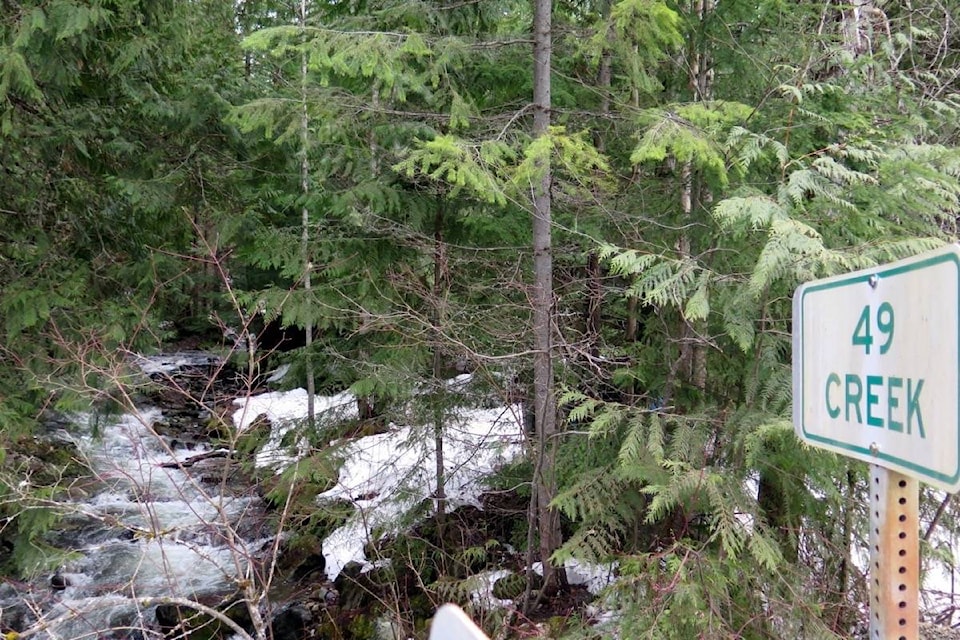Kelly Funk owns mineral rights to a piece of crown land near Blewett above 49 Creek. He wants to start exploration work this spring and has applied to the Ministry of Energy, Mines and Petroleum Resources to do that. Final permission has not yet been given.
The Blewett Conservation Society and the Blewett Watershed Committee have jointly sent a letter to the ministry expressing concerns about the work and its potential effect on the approximately 70 residential water licenses in the drainage. And a local resident has started a petition.
Jeff Berdusco, a mining consultant with the Cranbrook office of Moose Mountain Technical Services, is acting as the agent for Funk.
“This is a small scale exploration program, engaging registered professionals in every step,” Berdusco told the Star. He said the only machinery involved in this summer’s work would be one small excavator.
If the five-year permit is approved by the ministry, this summer’s activity would include the rehabilitation of a 100-year-old road to the property and excavation of 11 trenches about two metres long and one metre wide, Berdusco said. Samples taken from that work will indicate whether further exploration work is warranted next year.
“We have created a strict water management plan that has been drawn up by myself and reviewed and approved by Ministry of Environment staff in Victoria,” Berdusco said, “and also a terrain stability report to be approved prior to any construction.”
But the residents are not so easily reassured.
“Any time you have industrial activity on a class four slope (more than 60 per cent) there is concern,” says Gil Bogaard, who has been on the Blewett Watershed Committee for 35 years. “We have a healthy respect for the potential because of industrial activities in the past that have created problems for the creeks — mostly logging and road building and lack of maintenance afterwards.”
Following a meeting of 49 Creek water users on April 4, at which Bogaard says no residents were in favour of the project, a letter from the Blewett Watershed Committee and the Blewett Conservation Society to the ministry asks for rejection of the application. Failing that, they ask for 17 specific actions including an engineering report in addition to an already written terrain stability report due to steep terrain, as well as a road building, maintenance and decommissioning plan issued by a third party professional.
They also request an emergency response plan for the eventuality that drinking water is compromised, baseline testing of 49 Creek water quality by an independent agency, a fuel spill containment plan and a detailed plan on the rehabilitation and replanting of the drill sites and site roadways, a 30 day minimum work notice to water users rather than the current 48 hours, a fish and wildlife impact assessment, and a statement as to how the activity would benefit the Blewett community.
The Regional District of Central Kootenay also submitted a letter to the ministry, but the Star was not able to get a copy of it.
The mines ministry declined to be interviewed about its process or criteria in making decisions about exploration permits. But a ministry communications officer said by email, “Following a thorough review, statutory decision makers may authorize a permit, reject the application, or authorize the permit subject to site-specific conditions – specific requirements the proponent must undertake prior to, during and/or after any and all work authorized under the terms of the permit.”
A 206-signature petition organized by 49 Creek resident Kristina Van Veen expresses concern about acid rock drainage endangering fish and wildlife, noise pollution, slope stability, property values, the cost of cleanup and restoration efforts, emergency plans and safety measures.
Van Veen said she is not comforted by reassurances that this is a relatively small exploration effort in its early stages.
“My worry is that we constantly are being bombarded with information about mining,” she said, “constant reports on mining not going the way they planned, accidents happen, and it contaminates people’s water, and I don’t think that is a risk anyone here is willing to take.”
Berdusco explained that the permit Funk is requesting would allow him to extract 200 tons of mineral annually for five years. If at that point he wants to increase the amount of ore extracted, or if after five years he wants to move to more advanced extraction, he would have to apply for a new permit that would have stricter conditions.
“There is very minimal risk to water quality and quantity,” he said. “There are a lot of checks and balances in place.”
Ramona Faust, the RDCK representative for Area E, which includes 49 Creek, said development in watersheds are often dealt with in a piecemeal way.
“(The province) should conduct a cumulative impact study for Area E west with domestic and irrigation water quality and quantity and fish health and abundance being the subject of impact assessments. Dealing with applications on an ad hoc basis is not in anyone’s best interest.”
A similar concern was expressed by Bogaard.
“As small water users we are expected to protect ourselves from threats to our water quality and quantity, yet there is no government assistance for improvement.
“The West Kootenay has more small water licensees per capita than the rest of the province. It should be noted that the ministries of environment, mining, forests and health do not have, but should have, a local working group to coordinate activities in water sheds where there are multiple licensees.”
